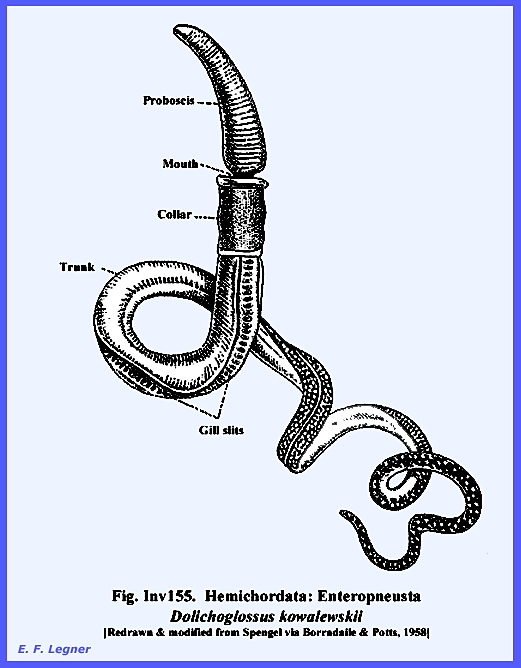File:
<hemichordata.htm> <Index to Invertebrates> <Bibliography> <Glossary>
Site Description <Navigate to Home>
|
Invertebrate
Zoology Kingdom: Animalia, Phylum: Hemichordata (Contact)
The Hemichordata
is a phylum of worm shaped marine animals that are often thought of as a
group closely related to the Echinodermata.
They were present in the Lower or Mid-Cambrian period so that there
many fossils called graptolites. Their bodies
are divided into three parts: (1) a proboscis,
(2) collar
and (3) trunk. They possess and open circulatory system
and a complete digestive tract. The gut
does not have well developed muscles and food is transported primarily
through it by cilia
that cover the inside surface. A stomochord or
diverticulum
of the foregut occurs that is probably related to the notochord of the
Chordata. However, this may be the
result of convergent evolution rather than homology. A hollow neural tube
is found in some species, which is thought to be a primitive trait that they
share with the common ancestor of the Chordata. General Characteristics of Hemichordata All members of the Hemichordata: Enteropneusta,
or acorn
worms, inhabit the marine
environment. They are wormlike,
burrowing and range in size up to one meter.
A type animal is Balanoglossus. Body
Regions. -- There are
three: a proboscis that resembles an
acorn, a collar and a trunk. Gill
Slits. -- These occur along
the sides of the trunk. They are closely
allied with the Chordata. Body
Plan. -- The mouth is located between the
proboscis and collar. The pharynx has
a diverticulum. The gill slits open
through the body wall and to the outside of the animal. A diverticulum runs from the pharynx,
which has been homologized with a notochord. Nerve
Cords. -- There is a dorsal
nerve cord, which may be hollow in a few forms. There is also a ventral nerve cord. Embryology.
-- The egg undergoes cleavage similar to the starfish and Amphioxis. They have a Tornaria larva,
which resembles the Auricularia larva of the Holothuroidea
(Echinodermata). This suggests an
echinoderm and chordate relationship. Economic
Importance. -- There is no
economic importance, however the animals give off an iodoform
odor. ============== |
